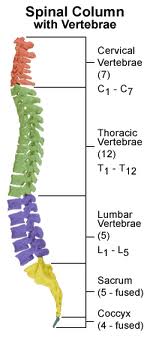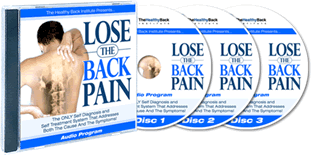What is Lower Back Pain
Lower back pain is the second most common reason Americans go to the doctor and this medical condition affects up to 80% of the adult population in the U.S. Each year 13 million people go to the doctor for chronic back pain.
When the spine’s flexibility, strength and stability are affected, it can cause discomfort, stiffness and pain. You are more prone to suffer from lower back pain because the low back supports most of your body’s weight.
Lower back pain can be classified as either acute (short-term) or chronic (long-term, continuous, ongoing).Acute lower back pain lasts less than 4 weeks and is normally not the result of any serious medical condition. In most cases you will improve within 1 week, even without medical attention. Chronic low back pain may lasts more than 3 months.
Lower Back Structure
Understanding our spine and how it works can help us understand why we have lower
back pain.
Our spine is a pillar of small bones, known as vertebrae, which are stacked on top of one another. Inter-vertebral disks, muscles, nerves and ligaments are the additional parts of our spine.
Our spinal column is grouped into different sections:
Cervical spine: 7 vertebrae that support the neck.
Thoracic spine: 12 vertebrae are connected to the ribs in the chest.
Lumbar spine: 5 vertebrae are the lowest and largest bones of the spinal column.
The sacral, a shield-shaped bone, connects our back to our pelvis.
The coccyx (tailbone) is at the end and composed tiny vertebrae fused together.
The lumbar vertebrae support most of our body’s weight and stress than any other part of our spine. This is why our lower back is the most likely to get hurt.
Lower Back Pain Symptoms
Depending on the underlying cause, the pain may be sharp or stabbing. It can be dull or achy.
Symptoms of low back pain may include:
- Stiffness, pain and tenderness, in the lower back
- Pain that radiates into the buttocks and hip area
- Difficulty in bending and lifting heavy things
- Difficulty in standing up or standing in one position for a long time
- Slight pain while sitting
- Weak and tired legs while walking
Lower Back Pain Causes
Lower back pain is usually caused by injury and strain through lifting heavy things, twisting, or bending. Sometimes performing a simple task like picking up a pen from the floor can hurt your back. In serious situations low back pain can be caused by an infection, a tumor, a rheumatic or arthritic medical condition.
Other common causes are:
- Herniated or ruptured disk
- Inherited spine abnormalities
- Degeneration of the disks
- Muscle spasm
- Pregnancy due to changes and weight distribution to your body.
Other serious conditions include:
- Tears to the muscles or ligaments supporting the back
- Spinal stenosis (narrowing of the spinal canal)
- Minor fractures to the spine from osteoporosis.
Lower Back Pain Prevention Tips
Low back pain is preventable and the following are some suggestions:
- Adopt a healthy diet and maintain a desirable weight.
- Exercise regularly.
- Maintain proper posture.
- Warm up and stretch before doing any intensive physical activities.
- Refrain from lengthy inactivity or bed rest.
- Avoid wearing high-heeled and uncomfortable shoes.
- Sleep on firm mattress to reduce any curve in your spine.
- Use ergonomically good work station.
- Bend you your knees when lifting heavy objects.
- Quit smoking as it weaken blood flow and deprive oxygen and nutrient to the spinal tissues.
Lower Back Pain Treatment
Lower back pain treatment may falls into one of following categories:
Medications
Medications used to treat low back pain include:
- Aspirin or acetaminophen
- Non-steroidal anti-inflammatory drugs (NSAIDs) like ibuprofen (Motrin, Advil) and naproxen(Aleve)
- Muscle relaxants such as carisoprodol (Soma)
- Steroids such as prednisone.
- Narcotic pain medications, such as codeine or morphine.
- Corticosteroid (cortisone shot) may also help decrease inflammation.
Alternative Therapies
- Physical therapies help you to adopt the correct posture, relax muscle tension, alleviate pain, and prevent long-term low back problems by enhancing muscle strength and joint stability. These therapies include hot and cold packs, massage, ultrasound and electrical stimulation.
- Active therapy includes cardiovascular exercises, stretching and weight lifting.
- Wrapping braces around your stomach offers good support to your back.
- Manipulation therapy involves Chiropractic care which helps to restore mobility and providing relief to you low back pain.
- Pilates and yoga offer great health benefits by developing your flexibility, strength, and balance.
Diet and Nutrition
- Keep your body in good shape by eating a healthy diet with lots of vegetables and fruits.
- Avoid foods that are high in saturated fat and sugar.
- Drink enough water to keep your body hydrated.
- Refrain from caffeine, alcohol, and tobacco.
- Consume supplements that help you fight inflammation and pain, such as Omega-3 fatty acids, flaxseed and fish oils.
- Take 500 – 1,500 mg of Glucosamine/chondroitin daily to help relieve arthritis pain, 3,000 mg of Methylsulfonylmethane (MSM), twice a day, to help prevent joint and connective tissue breakdown and 250 mg of Bromelain, twice a day to reduce inflammation.(consult your doctor before taking these supplements).
Herbs
Herbs are available in the forms of pills, capsules, or tablets.
- Turmeric for pain and inflammation.
- Devil’s claw to relieve pain.
- Willow bark to relieve pain.
- Capsaicin cream, applied to the skin to reduce inflammation and pain.
Homeopathy
Consult a homeopath to assess your physical and medical condition and the recommended therapies.
The following are some common remedies:
Aesculus – for dull pain with muscle weakness
Arnica montana – pain as a result of trauma
Colocynthis – weakness and cramping in the small of the back
Gnaphalium – sciatica that alternates with numbness
Lycopodium – burning pain, especially with gas or bloating
Rhus toxicodendron – stiffness and pain in the small of the back.
Hydrotherapy
Alternating hot and cold hydrotherapy may be effective for your back pain.
Acupuncture
Acupuncture may be effective for treating low back pain. It can be complex because many meridians (including the kidney, bladder, liver, and gallbladder) affect this area of the body. Studies have shown that people suffering from chronic lower back pain became better after receiving acupuncture treatment for six months, which is much better than from conventional therapy.
Surgery
Spinal Fusion
This procedure involves fusing the injured vertebrae into one solid bone. Spinal fusion removes motion between vertebral segments and eliminating any pain. Full recovery may a year or more.
Disc Replacement
This procedure involves removing the disk and substituting it with artificial parts, like the replacements of the hip or knee.
Surgical treatment for lower back pain should only be considered when options for nonsurgical treatment have been tried and unsuccessful. It is recommended that nonsurgical options be tried for 6 months to a year before considering surgery. Surgery may not be a suitable treatment for everyone.
Certain chronic low back pain conditions simply cannot be treated with surgery.
The Breakthrough System that’s PROVEN to Help Over 64,182 Folks (and counting) Eliminate Back Pain… Sciatica… and Herniated Discs… in less than 30 Days! Click Here




Pingback: Acupuncture Is Effective For Back Pain Treatment « Mide News